September 2025 Climatological Summary
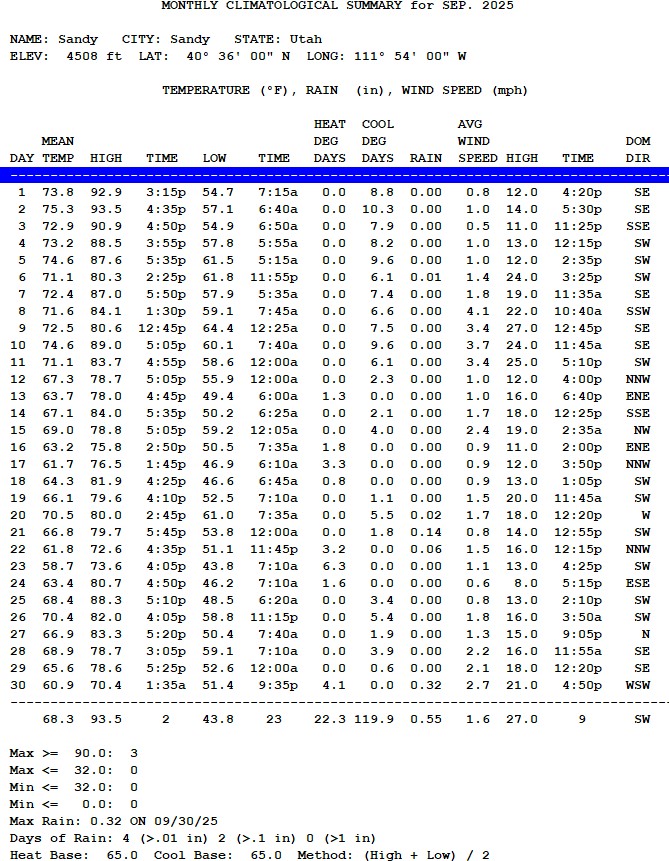
September was a pleasant month as usual. However, the month was on the dry side. From June through September, minimal precipitation was received, 1.27" (3.2 cm). This September logged only 0.55" (1.4 cm), with 0.32" (0.8 cm) (more than 50%) falling on the last day of the month.
Among the last four months, June was the driest, July had a little more, August had a little more, and to keep the string going, September had the most of these four months.
September had three days with temperatures more than 90°F. Often, there would have been a few more such hot days. The mean temperature was 68.3°F, compared to a 28-year average of 62.0°F. That's a difference of 6.3°F, significantly beyond what current Climate Change models would expect to see.
August 2025 Climatological Summary
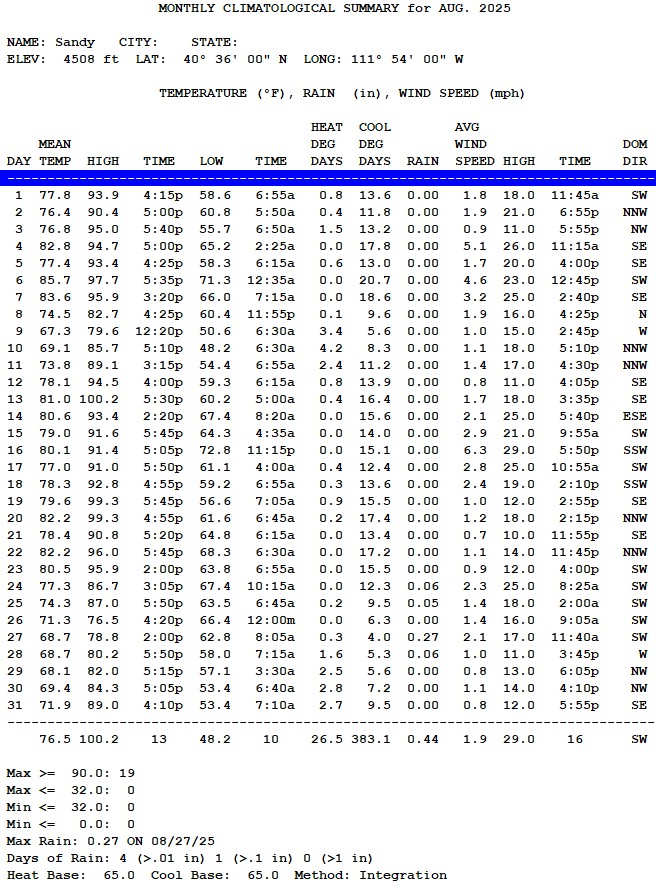
August has one day where the temperature exceeded 100°F (37.7 °C), as August 13th recorded 100.2°F (37.9 °C). On average, August records 7 days with temperatures over 100°F. The 28-year average temperature for August is 72.1 °F. For 2025, the average was 76.5°F (24.7 °C), again clearly showing that warming of our atmosphere is taking place.
July 2025 Climatological Summary
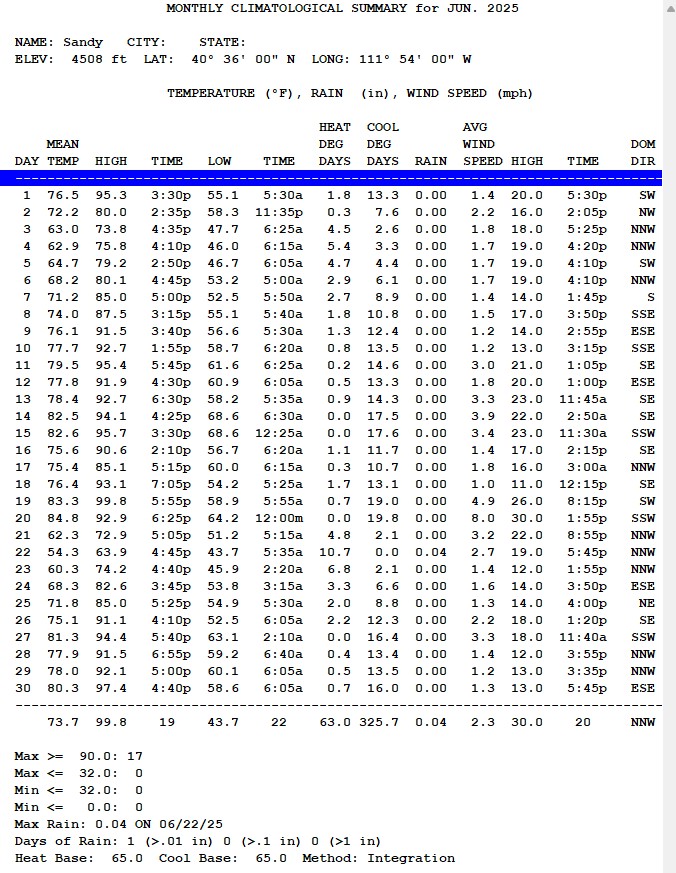
On average, July is the driest month of the year, just behind June and August. This year, July produced just 0.17" (0.4 cm). The total for the last three months is 0.70" (1.8 cm), while the total year to date is only 7.96" (30.3 cm). Normally, for the first seven months, the total precipitation is 11.93" (cm). We are well behind normal, which has increased the fire risk. Southern Utah has been drier. Let's hope we have the normal West Desert monsoon to provide water during the next two months.
The mean temperature for July 2025 was 79.8 °F (26.6 °C), while the 28-year average is 77.2 °F (25.1 °C). Strangely, there were no days when the temperature exceeded 100°F (37.8 °C). The warmest day was July 19, with a high of 98.6 °F (37.0 °C). The coldest day was July 1, with a low of 53.6 °F (12.0 °C).
June 2025 Climatological Summary

It is not unusual to have little precipitation in June. There have been multiple years when June has had no precipitation in the last 28 years. In 2025, we had little rainfall, just 0.04" (0.10 cm). The 28-year average is much higher at 0.94" (2.4 cm). The most precipitation in June was 3.79" (9.6 cm) in 1998.
It is not unusual for the first week in June to be stormy. In June 1968, it snowed at my parents' home in Holladay, Utah. I was 12 years old at the time and remember it well. It was the same week that Bobby Kennedy was shot and killed in Los Angeles, California. That said, this year and last, there were no storms during the first week.
May 2025 Climatological Summary
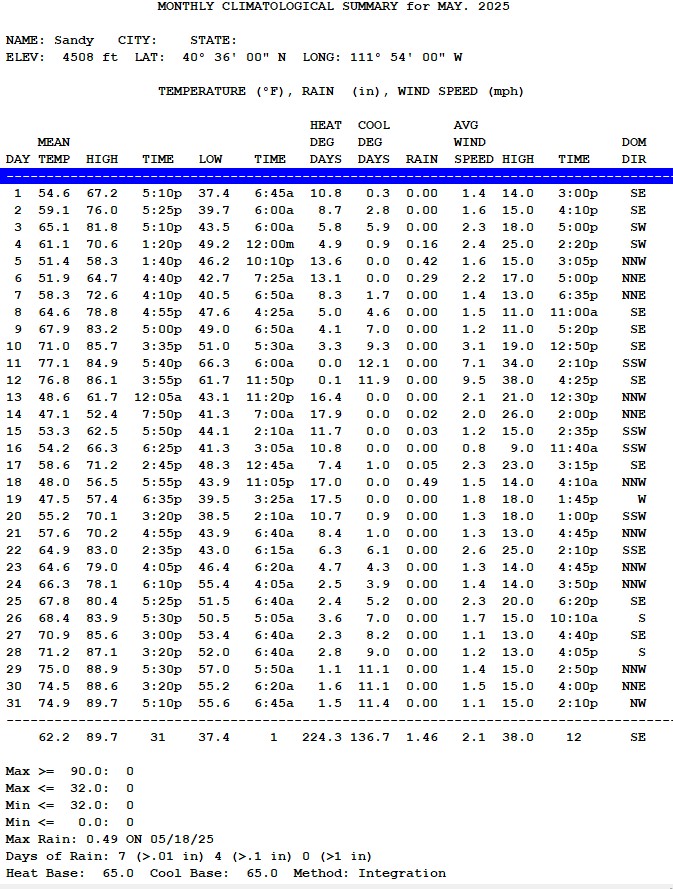
The average temperature was 62.2 F (16.8 C). This is close to the 28-year average of 61.9 F (16.6 C). The warmest day was May 31, with a high of 89.7 F (32.0 C). The coldest day was May 1, with a low of 37.4 F (3.0 C). The month was frost free.
The total precipitation was 1.46" (3.7 cm), somewhat shy of the 28-year average of 1.82" (4.6 cm). One third of that precipitation fell on May 18 0.49" (1.2 cm).
The wind was active on May 12th with a gust of 38 mph (61 km/hr). High winds near my home are unusual. The west side of the valley and the southeast corner of the valley are always windier. That said, the summertime flow of cool air out of the mountains most evenings is welcome.
April 2025 Climatological Summary
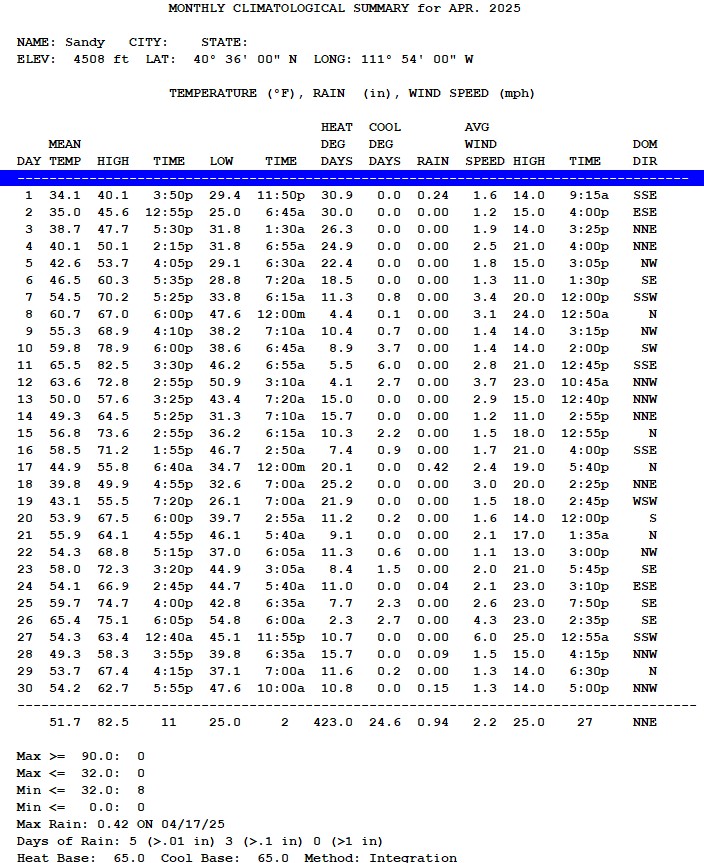
It is said, "April Showers bring May Flowers." I hope that's good enough because April 2025 had just one real rain storm (April 17 0.42" (1.1 cm)) and a bunch of showers. The total precipitation was 0.94" (2.4 cm) compared to the twenty-eight year average of 2.38" (6.0 cm). The most precipitation in April was 5.03" ( cm) in 2011
The mean temperature was 51.7 F (10.9 C), versus the 28-year average of 48.8 (9.3 C). Again, we see the monthly mean higher than the average. Global warming is real, even if few TV broadcasters dare to talk about it.
The warmest day was April 11, with a high of 82.5 F (28.1 C). The coldest day was April 2, with a low of 25.0 F (-3.9 C).The highest wind speed was a mere 25 mph (40.2 km/h) on April 27. Somehow, we picked a part of the valley where winds are seldom strong and never stronger than what is common in the sourtheast corner of the valley or in the middle and west sides of the Salt Lake Valley.
March 2025 Climatological Summary

March 2025 produced heavy precipitation for the Salt Lake City area. The total at my station was 3.26" (8.2 cm). The 28-year average for March is 2.08" (5.3 cm). The most for any March in the past 28 years is 4.62" (11.7 cm) recorded in 2019. The mountains also received abundant snow, thus northern Utah should be in good shape water-wise for the coming summer. Southern Utah is in a drought, and March 2025 did not help.
The warmest day wash March 26 with high temperature of 77.6 F (25.3 C),just shy of the 28-year record of 78.5 F (5.8 C) in 2002. The lowest temperature was 20.3 F (-6.5 C) on March 19. The mean temperature was 45.2 F (7.3 C) versus the 28-year average of 43.5 F (6.5 C). The mean was 1.7 F (0.8 C) above the 28-year average.
The heaviest snowfall for the winter season was 7" (17.8 cm) on March 18.
February 2025 Climatological Summary

The storms on the 20th and 21st provided 0.70" (1.8 cm) of precipitation, or 56% of the total 1.26" (3.2 cm) for February. That storm lifted the snow content in many locations in the nearby mountains to 100% of the normal for February. As time goes forward, we'll need to average 100% of normal until mid-April to end the winter season at 100%. The 28-year average for February is 1.61" (4.1 cm).
The mean temperature was 37.9 F (3.3 C) versus the 28-year average of 33.3 F (0.7 C). That's above the 2.5 C rise in global temperatures we are trying to avoid. With data like that, how can people say they can't see global warming happening right before their eyes? The low temperature of 7.7 F (-13.5 C) was a friigid February day. The 28-year record is 2.6 F (-16.3 C) set in 2010.
January 2025 Climatological Summary
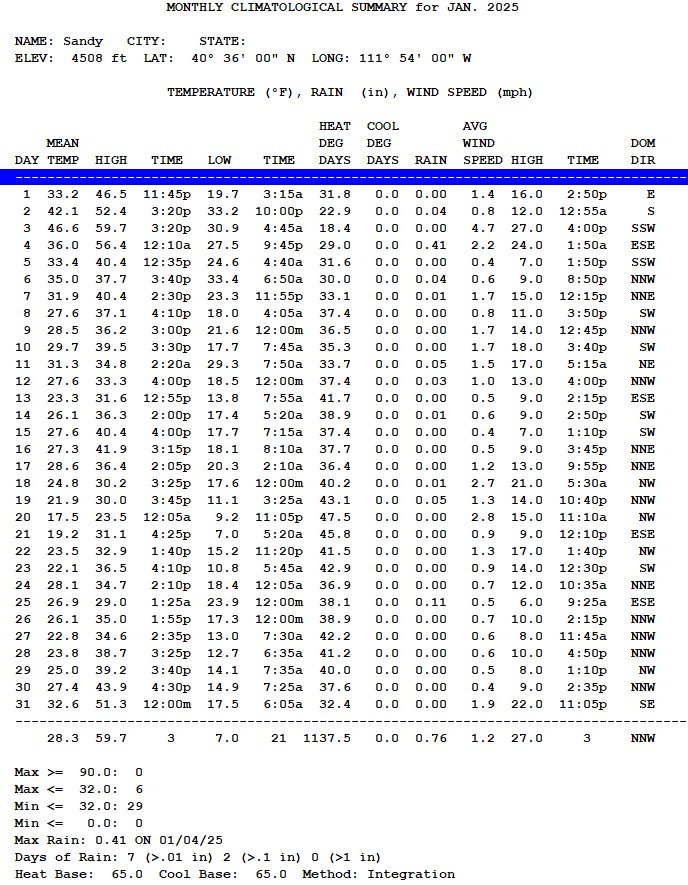
January 2025 was quite dry; only 0.76" (1.9 cm) fell. Yes, it seemed we often had 1-2" (2.5-5.1 cm) of snow, but it was dry powder snow with little water content. More than half of the water content fell on January 4th.
We can still have a decent water supply if the year's wettest months (March, April, May) are near or above normal.
The mean temperature was 28.3 F (-2.1 C). The twenty-eight-year average is 30.5 F (-0.8 C). The warmest day was January 3, with a high of 59.7 F (15.3 C). 62.1 F (16.7 C) during 2003 is the warmest January day in the past 28 years. After the 15th of the month, the temperatures turned cold. From January 17th through January 29th, the temperature never made 40 F (4.4 C). The lowest temperature was 7 F (-13.9 C) on January 21st. That is the coldest temperature of this winter season so far and will likely remain the coldest for this winter season.